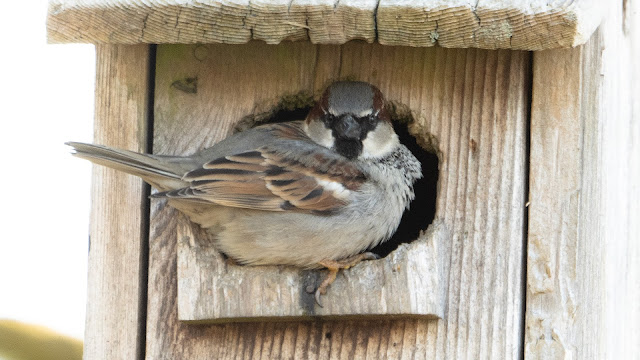Double VR - how is that possible?
 |
| Male house sparrow on a nest box in Langley, BC using double VR. |
Image stabilization, vibration reduction, optical stabilization - whatever you call it, the technology represented a game-changer for photographers. I remember when it first came out, I was amazed at how my minimum handheld shutter speed magically could be lowered by two, three, or even four stops. It was a boon to wildlife photographers as we could now use long lenses without having to resort to ridiculously high ISOs.
Nikon and Canon chose to build lenses with stabilization technology while other companies built it into their cameras' bodies. With the trend towards mirrorless cameras well underway, the two dominant camera corporations now build their Z-type cameras with in-body-image-stabalization (IBIS). So, you now have a choice. When using a mirrorless camera with a VR/IS lens you can turn off IBIS and use the lens's system, turn off the lens's system and use the bodies, or use both.
Wait, what? You can have double VR? It turns out that you can.
For Nikon (my brand of choice), a F-series lens with VR can be operated on a Z-series mirrorless camera using the FTZ adapter (F mount To Z mount). You can have both the lens's VR and the body's IBIS turned on at the same time. They work in tandem and provide better stabilization than either one would independently. It's not the perfect system, but it may give you that extra edge you need for some photos.
One of the major shutter speed issues comes from subject movement. Wildlife and sports photographers are both well aware that you can have the best stabilization system going and still end up with a blurry subject. Put a camera system on a tripod, make it perfectly still with an electronic shutter and no movement from VR or IBIS tech and you will end up with perfectly formed branches or goalposts but blurs from the roving subjects.
The downside to using double VR is that camera battery life will degrade at a faster rate. With all the electronic mechanisms drawing power, having a spare battery is a good idea. Also, since subject blur is a real threat to image integrity, keeping shutter speeds at terribly low levels is not recommended, so it turns out that it may be a waste as one system or the other could do the job.
It's good to know though that it works. I invite you to play with the double VR concept and see if it makes a difference in your photos. I'd like to know what you think.
Thanks for reading.
Eric Svendsen www.ericspix.com



Comments
Post a Comment